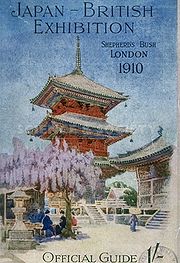
Ōshima Joun
Encyclopedia
was a Japan
ese sculptor and artist, noted for his great artistry and skill in bronze casting. There appears to be some debate about the correct attribution of the gō (or art-name
) Ōshima Joun to either Ōshima Katsujiro or his brother Ōshima Yasutaro. Both were noted artists in metal, so the other gō in use at the time, Ōshima Shōkaku (var. Shokaken
), could belong to either brother, thus an authoritative history of the matter is needed. The two brothers managed a workshop under the business name Sanseisha, which during the period 1875 to 1879 "produced some of the finest bronzes ever produced in Japan."
 Joun was born to a family of metalworkers and was famous for his skill in casting bronze. He was the son of Ōshima Takajiro, whose own father Ōshima Yasubei was the first metal craftsman in the family. He was a professor at the Tokyo School of Fine Arts (東京美術学校 Tōkyō Bijutsu Gakkō; name changed in 2008 to Tokyo University of the Arts) from 1887 until 1932. The studio, Sanseisha, was very successful and at one point employed 11 assistants. Many of Joun's students (Ryūki, Chōkichi Suzuki (see mention in Victoria and Albert Museum
Joun was born to a family of metalworkers and was famous for his skill in casting bronze. He was the son of Ōshima Takajiro, whose own father Ōshima Yasubei was the first metal craftsman in the family. He was a professor at the Tokyo School of Fine Arts (東京美術学校 Tōkyō Bijutsu Gakkō; name changed in 2008 to Tokyo University of the Arts) from 1887 until 1932. The studio, Sanseisha, was very successful and at one point employed 11 assistants. Many of Joun's students (Ryūki, Chōkichi Suzuki (see mention in Victoria and Albert Museum
), Sessei Okazaki, Kumazō Hasegawa, Gorosaburō Kanaya, Eisuke Jomi) went on to achieve distinction of their own. He exhibited at the 2nd National Industrial Exposition in 1881, and at the Paris Exposition Universelle (1900)
, and the Japan-British Exhibition of 1910.
Ōshima Joun died in Tokyo on January 4, 1940, at 83 years old.
Japan
Japan is an island nation in East Asia. Located in the Pacific Ocean, it lies to the east of the Sea of Japan, China, North Korea, South Korea and Russia, stretching from the Sea of Okhotsk in the north to the East China Sea and Taiwan in the south...
ese sculptor and artist, noted for his great artistry and skill in bronze casting. There appears to be some debate about the correct attribution of the gō (or art-name
Art-name
An art-name is a pseudonym, or penname, used by an East Asian artist, which they sometimes change. The word and the idea to use a pseudonym originated from China, then became popular in other East Asian countries ....
) Ōshima Joun to either Ōshima Katsujiro or his brother Ōshima Yasutaro. Both were noted artists in metal, so the other gō in use at the time, Ōshima Shōkaku (var. Shokaken
), could belong to either brother, thus an authoritative history of the matter is needed. The two brothers managed a workshop under the business name Sanseisha, which during the period 1875 to 1879 "produced some of the finest bronzes ever produced in Japan."
Career

Victoria and Albert Museum
The Victoria and Albert Museum , set in the Brompton district of The Royal Borough of Kensington and Chelsea, London, England, is the world's largest museum of decorative arts and design, housing a permanent collection of over 4.5 million objects...
), Sessei Okazaki, Kumazō Hasegawa, Gorosaburō Kanaya, Eisuke Jomi) went on to achieve distinction of their own. He exhibited at the 2nd National Industrial Exposition in 1881, and at the Paris Exposition Universelle (1900)
Exposition Universelle (1900)
The Exposition Universelle of 1900 was a world's fair held in Paris, France, from April 15 to November 12, 1900, to celebrate the achievements of the past century and to accelerate development into the next...
, and the Japan-British Exhibition of 1910.
Ōshima Joun died in Tokyo on January 4, 1940, at 83 years old.
External links
- Ōshima Joun holdings at the University Art Museum of Tokyo University of the Arts
- Instructors Ōshima Joun (Jo'un Oshima) and Sessei Okazaki are listed in this too-brief history paragraph of the Metal Casting Department of the Tokyo University of the Arts as leaders of the arts and crafts movement in Japan
- Ōshima Joun on Artnet.com
- Ōshima Joun at Bonhams

